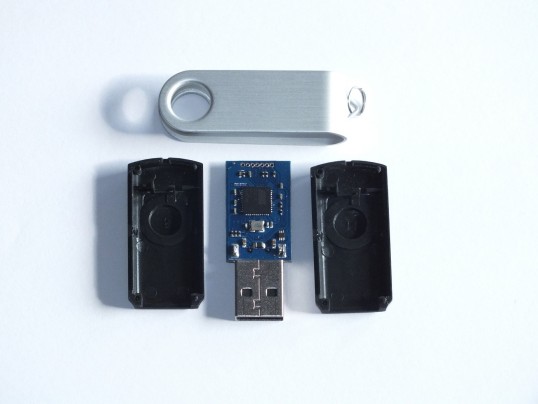- Artificial Intelligence (AI)
- Occupational exposure limit values
- Climate Change and Occupational Safety
- List of CMR substances
- Electromagnetic fields
- Ergonomics
- Industrial Security
- Collaborative robots
- Noise
- Nanoparticles at the workplace
- Optische Strahlung
- REACH
- Reference materials
- Proficiency testing
- Vibration
- Virtual reality
- Work 4.0
Industrial Security
Protecting safety functions on machinery and plants from attacks

Tampered USB stick as a gateway enables attacks on industrial control systems
Source: IFA
Functional safety components protect life and health when working on plants and machinery. For instance, a safety locking function can prevent a safety gate to a hazardous zone of a plant or machine from being opened. To ensure that safety functions of control systems are reliable, the control system itself must also be secure, i.e. protected against tampering.
Safety components must therefore be
- adapted to their technical environments (networks, interfaces, communication protocols, etc.),
- protected against tampering and
- protected against attacks.
The annual State of IT Security Report of the German Federal Office for Information Security (BSI) shows how frequently specific attacs have been observed. The reports describe, for example, attacks on industrial controls capable of putting a blast furnace in a steel plant out of control or instances where a safety control system was hijacked in a chemical plant.
Protection against attacks is therefore imperative, especially for functional safety components.
The DGUV works towards an effective improvement of this situation in a number of different areas:
- The Institute for Occupational Safety and Health (IFA) trains Social Accident Insurance Institutions, raises security awareness through practical demonstrations of attacks and develops solutions.
- A working group of the DGUV Test Department has worked with the test laboratories of Social Accident Insurance Institutions and the IFA, drawing up a test principle for security in industrial control systems based on the IEC ISO 62443 standard.
- The IFA also provides further information on the latest safety and security warnings for supervisors, manufacturers and insured companies.

Common Security Advisory Framework (CSAF)
Technical Information on this open standard for providing information in standardized form on vulnerabilities in digital products
Security Regulations

Machinery Regulation: Regulation (EU) 2023/1230 of the European Parliament and of the Council of 14 June 2023 on machinery and repealing Directive 2006/42/EC of the European Parliament and of the Council and Council Directive 73/361/EEC
Cybersecurity Act
Regulation (EU) 2019/881 of the European Parliament and of the Council of 17 April 2019 on ENISA (the European Union Agency for Cybersecurity) and on information and communications technology cybersecurity certification and repealing Regulation (EU) No 526/2013
NIS Directive
Directive (EU) 2016/1148 of the European Parliament and of the Council of 6 July 2016 concerning measures for a high common level of security of network and information systems across the Union
NIS 2 Directive
Directive (EU) 2022/2555 of the European Parliament and of the Council of 14 December 2022 on measures for a high common level of cybersecurity across the Union, amending Regulation (EU) No 910/2014 and Directive (EU) 2018/1972, and repealing Directive (EU) 2016/1148
Cyber Resilience Act
Regulation of the European Parliament and of the Council on horizontal cybersecurity requirements for products with digital elements and amending regulation (EU) 2019/1020
Feedback from DGUV
on the initiative: Cyber resilience act – new cybersecurity rules for digital products and ancillary services (in German)
Technical Regulation for Operational Safety Part 1 / Technische Regel für Betriebssicherheit (TRBS) 1115 Teil 1
"Cybersicherheit für sicherheitsrelevante Mess-, Steuer- und Regeleinrichtungen" (in German only)
Publications
